Thanks to Mr. Tretiak. Visit his blog here.
In this part of my series on games and how they don’t always (or sometimes outright ignore) how AFVs actually operate, we’ll be covering how games don’t really cover how a tank crew keeps stock of their surroundings.
While I figure it’s usually safe to assume people are aware of this, I’ll just touch on a few basics about how this was and is currently done, both in a modern and historical context.
What we need to keep in mind, starting out, is that a tank is essentially a giant steel bunker with tracks, turret, and a main gun. It is designed to repel all sorts of external threats and damage, from small infantry weapons like pistols and rifles, to shrugging off shrapnel and large bore artillery explosions (in their general area, at least). To do so, even today, tanks limit number of holes or other openings that are readily accessible or exposed, to ensure the strongest possible protection against these various external threats. This means that tanks are relatively isolated, internally, from their external surroundings, especially when it comes to your normal senses, such as sight, hearing, and smell. It may help some to consider that being in a tank is similar to being in a submarine (ok, not really, but bear with me). You are at the mercy of what you can see or detect, but you have a limited amount of tools at your disposal to detect the threats around you or to select targets offensively. This is an issue that has been a long standing issue with armored fighting vehicles since they first started showing up.
Early tanks and vehicles essentially had little vision slits that provided some view of the area directly overlooked by the slit. So drivers could see a narrow little band of space before them, gunners could see little strips of what was directly before their guns, etc. To overcome this, many early tanks would have multiple crew members with multiple gun sponsons (essentially a hull mounted gun turret) laid out around the periphery of the tank to cover multiple angles with fire. They also would have the vehicle commander try to keep an eye out on their surroundings, by using either an armored cupola or similar construct with vision slits to permit them a better sense of their surroundings. These early vehicles, like the British Mk V, were slow, extremely ungainly, and had difficulty maneuvering, though they still made a difference with crossing trenches and helping break some of the stalemate of the war. During the war and afterwards, it was noted that these crude vision slits were very limited in several ways. One, that they were rarely ‘covered’, letting in bullets, snow, rain, ash, smoke and the like into crew compartment. Those that could be closed, were still a weakness in the armor of the vehicle. Long range vision in an early tank was generally accomplished via a man with binoculars, either looking out of an opened hatch, door, or large observation position on the vehicle. Gunnery sights were crude.
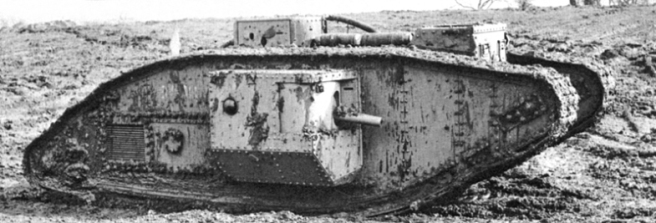
As time progressed, leading up to the Second World War, various nations experimented with new technologies and manufacturing techniques to try to provide both good visibility from inside the tank, while improving the protection and security of the crew. The vision slit still remained, early in the war, but was gradually replaced by periscopes and sight prisms that allowed for better protection and fewer points of compromise in the armor layout.
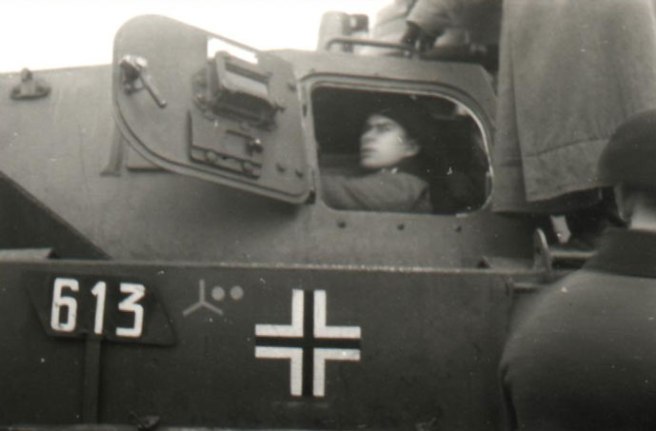
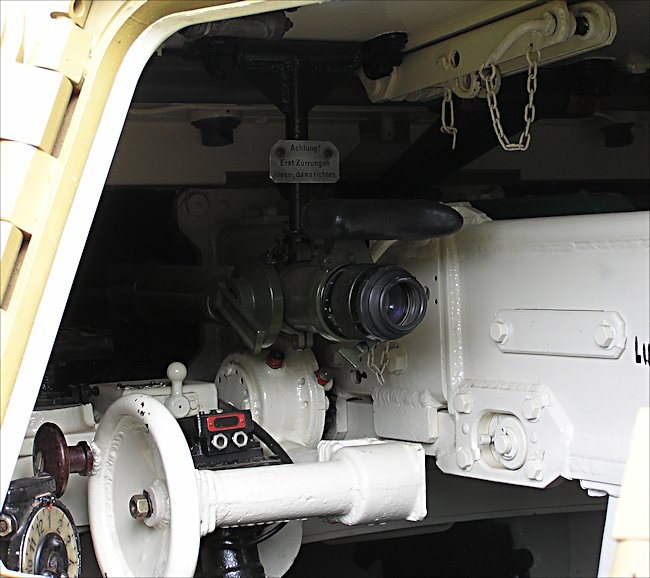
The gun sight on a Panzer III. I am uncertain of either the source of the image or the model of the Panzer III, but one can see through the open hatch, the conventional layout of the vehicle, in accordance with the Heer’s standards during the war.
Guns got better long range performance and sights were improved to increase the effective accuracy of these better weapons. While the Germans produced very accurate and easy to use gunnery sights, they were very expensive and complex, and had a limited field of view. German gunners rarely had any sort of back up sight or wide-view periscope to assist in target acquisition, which limited their effectiveness, relying on the vehicle commander in particular to help guide them on to a target. Other crew generally had very limited options for seeing, though in some cases (such as the hull MG/radioman and the loader) this was not strictly speaking needed for them to do their basic jobs. It was shown, however, that (surprise surprise) more eyes scanning the surrounding area made for much more effective operation of the vehicle, either while it was moving or when it was trying to identify targets.The Allies produced their own gunnery sights that, while generally not as sophisticated, were perfectly functional and also had begun to provide gunners with secondary sights for better situational awareness.
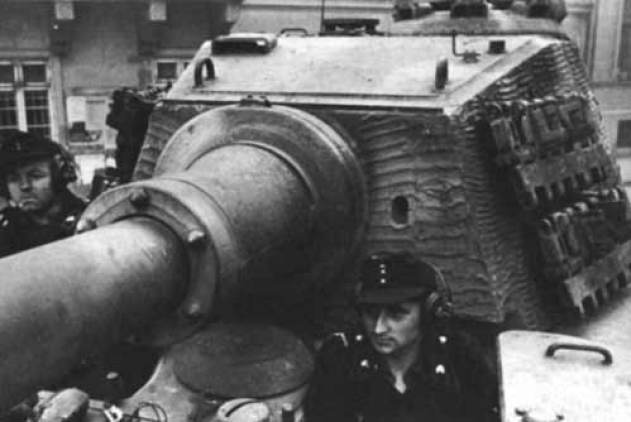
The turret of a ‘Königstiger’ aka Tiger II (H). Position of the various sights and vision systems: bottom right is the driver, seated unbuttoned from his position in the hull. Directly above him, on the turret, is the hole in the turret front where the gunners sight is located. Directly behind that, on the top right of the turret is the commander’s cupola, with the distinctive late-war dome and multiple vision prisms. To the left, located above the gun on the forward turret roof plate, is the loader’s forward vision periscope.
Near the end of the war, multiple sides had nearly finished or started to put out crude night-vision technology, allowing for a limited improvement in night combat abilities.
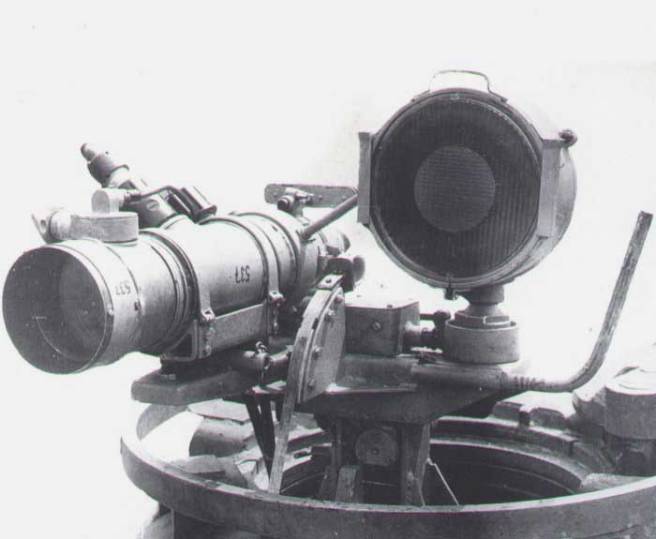
A late-World War II German infrared night-vision device with an illuminator spotlight. It seems to be mounted on a Panther’s commander’s cupola. While limited in range and offering a poor image, it represents some of the first steps towards improving tank crew’s ability to operate with extended sensory equipment.
Even with the advances and improvements made, it was found that situational awareness, especially for near or around the vehicle, was incredibly poor, leaving tanks extremely vulnerable to flanking and and infantry. The most reliable means for a tank crew to ascertain the nearby conditions and environment is to open their hatches and look around ‘unbuttoned’. This gives excellent situational awareness, though perhaps for obvious reasons, it has major drawbacks. The most cynical among us could successfully argue, for instance, that having a tank commander taken out by a sniper certainly would increase the vehicle crew’s general situational awareness to the threat of nearby infantry. That said, it is not the best course of action when one suspects nearby infantry or enemies, forcing crews to either rely on friendly troops or vehicles to overlap their vision or otherwise protect them from such situations. However, even today, it is easier and most effective to drive a tank or check the local situation by popping your head out of the hatch to have a look around, provided you’re not suicidal or otherwise engaged in combat.
More recent improvements to tanks include a wide range of sensors and devices that allow for better vision during the day and night, full thermal vision, and even devices that can assist in detecting the direction where gun fire has come from. Other improvements, either being developed or tested, including direct feeds from local UAVs, remote cameras mounted to cover various angles of the vehicle, GPS navigation, and military data networking that allows for real-time information being transmitted to various vehicle crews across the field of battle. Yet all of this still doesn’t change that you are still in a giant metal bunker with limited options for viewing or observing your immediate vicinity. It only mitigates this reality and help improve the function and efficiency of the vehicle crew.
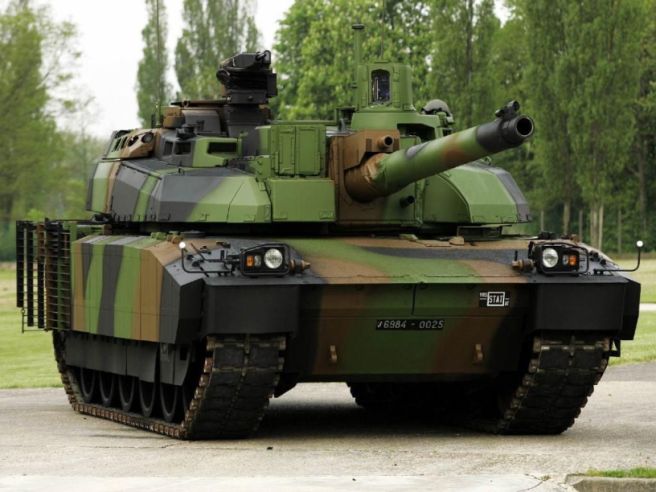
So, how do video games usually stack up to this reality? Generally, not very well on average (with some notable stand outs). Let’s see what some of the contenders are!
The Battlefield Series
Perhaps surprisingly, the Battlefield Series has made some efforts to reflect the fact that you can only see a limited amount of space when you’re in a tank, and should be generally commended for that. Are they the most accurate or well-thought out presentations? Ehhh, not perfect. They still do a better job than some other games I’ll mention, however.
World of Tanks
World of Tanks does rather poorly, all told, in how it handles tank visibility and situational awareness, though this can perhaps be written off a little as the game isn’t trying to simulate real tank combat. Rather, it uses game mechanics (vehicle sight vision, making tanks invisible, etc) to ‘simulate’ the limited vision and awareness a tank crew might experience. However, with a third person view and tank gunnery sights that are limited at best, and outright fanciful at worst, it’s not really the paragon of realism (nor does it try to be in most cases). Armored Warfare falls into the same general category, though it gets a special shout-out for it looking into, at least, night vision and thermal devices in the future, which would be pretty neat and allow for night fights in the game.
War Thunder
War Thunder is fairly similar to World of Tanks in some cases, where in others, it can be significantly better. It really depends on what type of game mode and game experience you are looking for as a gamer. Arcade matches feel very similar to World of Tanks in a lot of ways, though there are clear differences in approach (for instance, game balance does not really exist in the same way that it does in World of Tanks). With Simulator battles, however, tanking becomes much more about your own situational awareness and using the tools they provide to make the maximum use of your vehicle and its armor in combat. They incorporate various real-world analogs that would be shared across virtually all tanks of the era. Here’s a basic list of this vision characteristics: the gun sight is adjustable, you can simulate viewing things through a tank commander’s binoculars, seeing through the driver’s periscope/prism, or even being unbuttoned from the commander’s hatch (kinda). The game still has some major issues, though, for the hardcore tank simulation crowd, as the gunnery sights are not unique to the country (they varied in sophistication and operating method for different models and countries in real life) and still feel more tacked on, than as fine-tuned mechanics. Still, the experience is a bit more ‘authentic’ to what it might be like to be in an actual tank and try to take stock of your surroundings than either Battlefield or World of Tanks.
The Red Orchestra Series
Ah, Red Orchestra: Ostrfront, Mare Nostrum, and Darkest Hour. These were, for the longest time, my personal staples for World War II tank combat. I loved how you had to manually dial in the range of a target and sight it, how you were always in danger if you poked your head out for a quick look around at your surroundings. They tried, very, very hard to replicate the sense of isolation a tank crew might feel and the dilemma of exposing yourself to enemy fire in order to gain a better sense of the situation around you. Was it perfect? No, not really. But they did a great job, especially for what were all fairly advanced gameplay concepts for their era and if someone is looking for a cheap tanking simulation thrill, it’s a good place to go if you don’t mind the inaccuracies and more game-y elements you might encounter (or bad armor simulation). Not just that, but you can run most of a full tank crew, depending on the vehicle, with driver, commander, gunner, and hull gunner all being playable by other players (and a positive blast when you have friends who want to join you in running a tank).
Red Orchestra 2: Heroes of Stalingrad and Rising Storm do an even better job, albeit with a much, much smaller pool of vehicles and tanks. The internal models of their vehicles (The Panzer IV and T-34, along with a recent expansion that includes additional vehicles) and how they work, the vision slots and your limited options for looking around, all of these can really bring home the isolated world inside of a tank. I frankly adore that they have tried to do this, though I lament their continued lack of additional vehicles, such as the IS, KV-2, or Tiger (to name a few of the, many, many vehicles they’re lacking). However, it’s clear that each one would represent a significant and very time consuming and expensive investment to produce, despite how absolutely gaga I would be for Tripwire Interactive to create them. I can only hope and look forward towards the future and the modding community.
The ArmA Series
I love ArmA. I truly do. But when it comes to vehicles and vehicle combat, it has some major weaknesses and lets armor-orientated players down a fair bit. Yes, it’s mostly infantry focused, yes its not a full on combat simulator. But one had hoped, given that they have done a great job with modeling the interiors of helicopters, trucks, airplanes, and even the transportation compartments of an APC or IFV, they might also model the interior of a tank or other AFVs with the same vigor. Sadly, they have not and probably will not in the foreseeable future, much to my disappointment. That said, the ArmA modding community has made significant efforts to rectify this terrible tragedy, and various mods and efforts have made or are making mods that replicate the interior of these vehicles and how they might or do operate. My only current qualm is third person views, which I think breaks immersion for me and others, though its simple enough to find a server or group that limits vision to first-person only.
All told, games have made efforts to help replicate, if not directly simulate this aspect of operating an armored vehicle. In any game where multiple crew positions are available in a first person mode, it really can immerse players in the unique challenges faced when one is in a tank and it really is quite unlike anything else when its done well.


